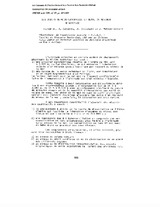| dc.description.abstract | Summary.
Splanchnic blood flow was measured in fifteen young healthy subjects in La Paz, Bolivia (3.750 m.) at rest, during mild exercise and under oxygen (PIO₂ = 150 mmHg). The hematocrit of 9 of the subjects was normal for altitude whereas 6 has a low hematocrit as they were blood donors. Values did not differ between the two groups neither at rest (1,55 +- 0,55 1.min-1). ;1,67 +- 0,28 1.min-1) nor during exercise (1,43 +- 0,28 1.min-1). Correction of hypoxia had no influence on blood flow. Oxygen consumption of the splanchnic vascular bed was similar to that at sea level. Lactate-glucose consumption-production ratio was higher at altitude and brought back to sea level values under oxygen. Liver function could therefore be considered similar to that at sea level providing that the inflow of oxygen was the same. | es_ES |

